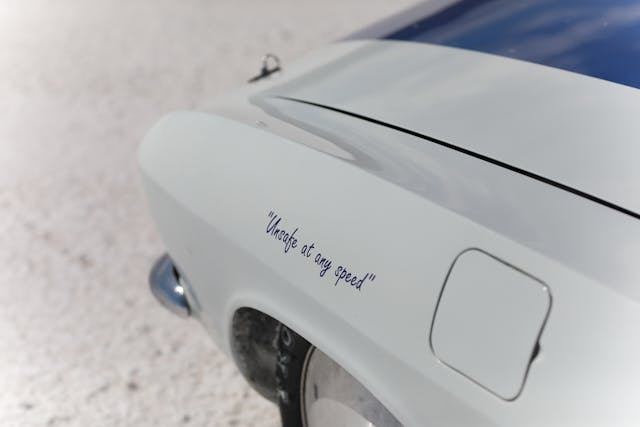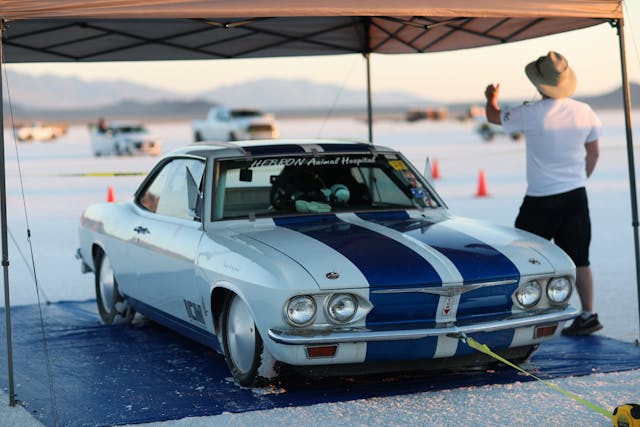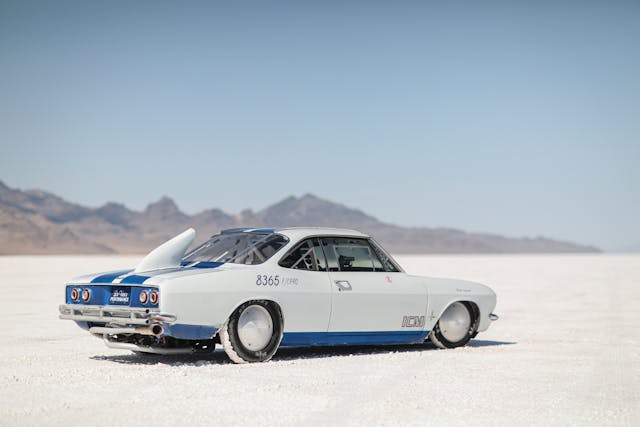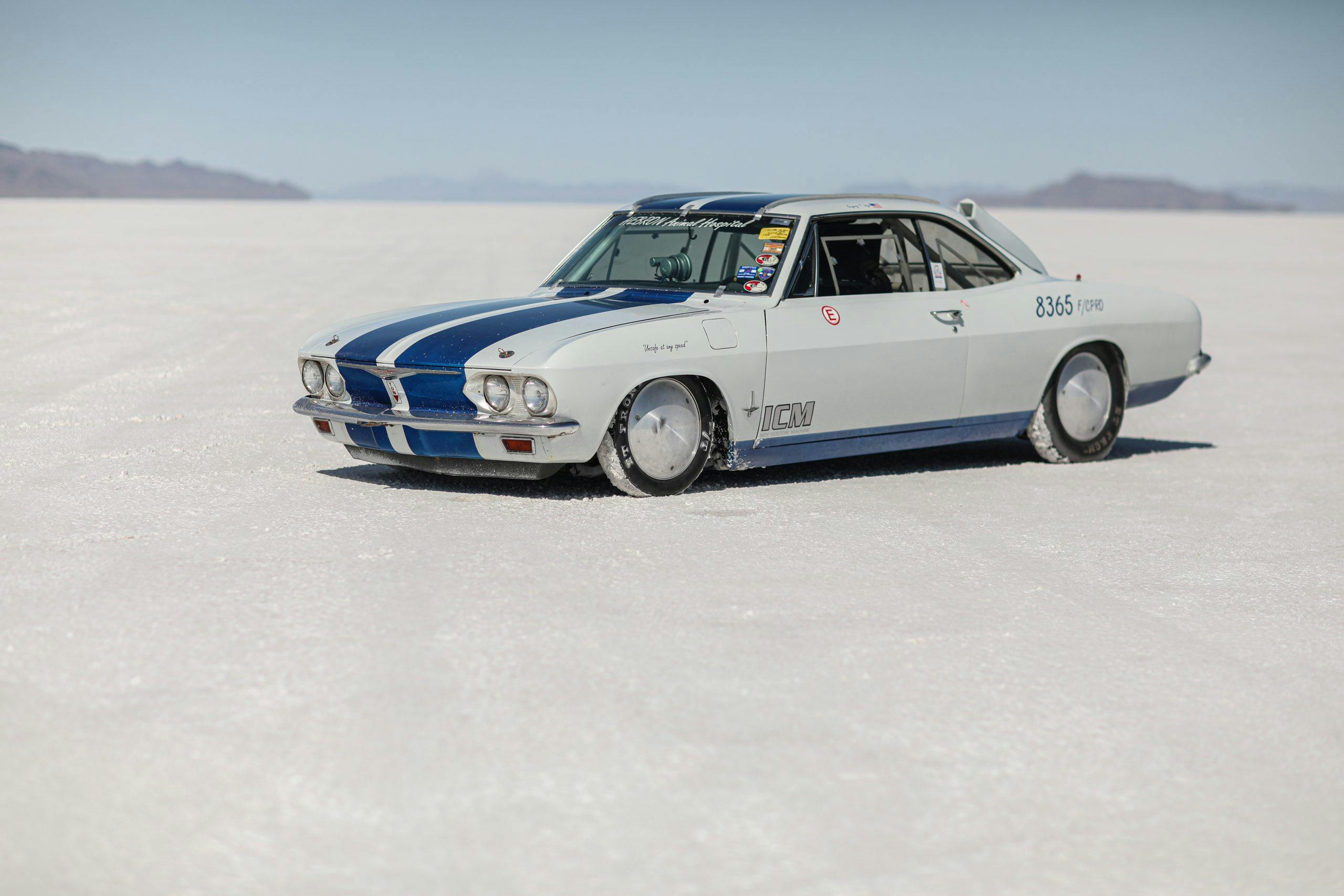Media | Articles
Corvair racers capture land speed records on the Bonneville salt
You’re looking at the current record holder of the SCTA’s F/Classic Production class. For now, at least. In the last few years, there’s been some competition in the Bonneville classic production classes, where body modifications are minimal and aerodynamics can be tricky.
This particular Corvair racing endeavor started three years ago. Greg Lloyd and Rick Deerwester were driving back to Kentucky from Bonneville Speed Week 2017. Lloyd had just helped Deerwester crew on his G/Classic Production (G/CPRO) Porsche 924 and decided then and there that he was going to go after a record of his own. With 30 hours of driving ahead of them, Lloyd had plenty of time to scour the Southern California Timing Association (SCTA) rulebook and find a record that he felt was beatable.
Lloyd didn’t’ have to look too far from the class he and Deerwester were competing in to find a worthy target. If he could find a car with an engine slightly under 3.0 liters, the F/CPRO class seemed within reach. After some back and forth with Deerwester, the idea of a Corvair came up. Neither knew much about the cars at the time, but they were pretty sure the Chevy’s flat-six powerplant was in the right ballpark. As Lloyd often says about his addiction to land speed racing, “It’s all Rick’s fault.” That phrase is even on their race shirts and has become the unofficial team name.
Once back in Kentucky, some research with his road-racing connections brought Lloyd to Michael LeVeque at LeVair Performance. LeVeque has been building and racing Corvairs for 25 years and even had the right car to kickstart Lloyd on his quest for land speed records: his personal daily driver that he sold to Lloyd.
In the 9-10 months that followed, Lloyd and LeVeque stripped the car and totally rebuilt it into the race car you see here. LeVeque, a talented fabricator and welder, built the roll cage as well as the engine. “He used every trick he knew,” Lloyd noted, admitting that the team would need all the power they could squeeze from the little flat-six. Originally 2.7 liters, larger bores brought displacement to just a hair under 3.0 liters—perfect for the F engine class at Bonneville.
Marketplace
Buy and sell classics with confidence
In the quest for more airflow and power, LeVeque started with a stock 140 head, which offered the largest valves of any of the factory cylinder heads. From there, he welded in the spark plug holes and reshaped the combustion chambers, mimicking the shape of Chevrolet’s potent Vortec cylinder heads. A new heart-shaped chamber offered improved flow past the valves along with a big bump in compression, to 12.5:1. New angled spark plug ports were drilled to accommodate the new, larger valves, and the factory intake log was milled off. That allowed LeVeque to create a custom, long-runner tunnel ram that feeds all six cylinders from a centrally mounted Holley 650CFM carburetor.
When combined with the big camshaft that offers 312 degrees of advertised duration, this engine only comes alive at about 4000 rpm, on the way to its 6300-rpm power peak where it puts out 198 horsepower to the wheels at Utah’s 4000+ foot elevation.
Those kinds of engine speeds would have been hell on the factory fan belt, which makes quite a journey in its factory orientation. The crankshaft is horizontal, and so is the crank pulley, but the fan is perpendicular, its axis pointing vertically. Rather than keep the factory setup, LeVeque designed his own system that is inspired by the Porsche 911’s fan. Keeping the fan pulley, belt, and crank pulley in the same plane allows it to keep the engine happy as it wails along the salt.
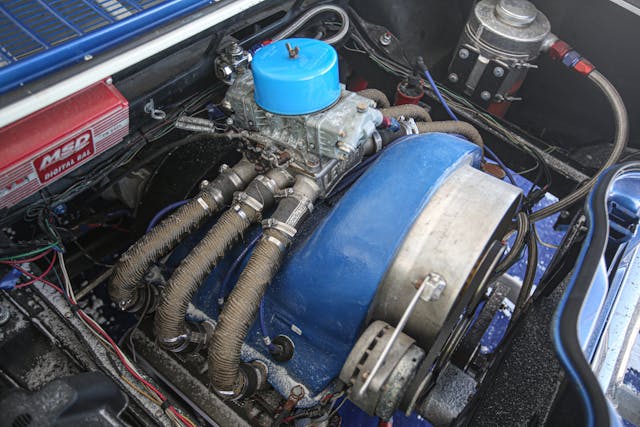
The engine is so high-strung that Lloyd needs all the help he can get at the starting line from the push truck. Once he reaches about 30 mph he pops the clutch and pulls away. The car uses the factory Corvair four-speed transaxle housing, but LeVeque pirated gears from other Saginaw boxes and did some custom machining to get a closer ratio than factory. First gear is good for about 78 mph at 7200 rpm. Shifting to second gear, the Corvair will keep pulling to 103 mph. Third gear goes to 128 mph and fourth gear is where the records will hopefully fall. The team had the transmission gears REM polished to reduce friction and improve efficiency. Every horsepower counts when you’re only making 200 hp to begin with, and the altitude robs the engine of oxygen.

In 2018 Greg and his crew, comprised of his son, Ben, along with Michael LeVeque and Michael’s brother, Scott, captured the F/CPRO record at 138.742 mph only to have it fall a month later when the Montana Vigilante team ran their Chevy Citation X11 to a two-run average of 142.925 mph. Speed Week was a bust for most racers in 2019, and this Corvair didn’t fare any better. After weather delays pushed racing back several days, Lloyd finally got his chance to make a run. Just as he was passing 125 mph he hit a rut on the course and spun out. Rather than risk another spin on the poor salt surface, the team packed it up and headed home.
The conditions for Speed Week 2020 were much better. After some tow rig trouble made them late to the salt they flew through tech inspection and everything went smoothly. “When the salt is right … the car is rock solid.” said Lloyd. With 250 pounds of ballast in the back seat, the Corvair handled perfectly with no lift at speed. They qualified for their record on Saturday and went to impound. Sunday’s return run fell short of the record but they qualified again on Monday. Tuesday’s return run was just as smooth and the team captured the record once again, this time at 146.125 mph.
Lloyd has become an air-cooled convert since racing his car. “Now I’m a complete fan of the Corvair,” he said. He currently has a 1965 Corsa that is getting a 3.1-liter engine and there are plans for more records in the race car. After he gets back from Loring Maine’s standing 1.5-mile race, a new engine will be built to go after the E/Classic Supercharged Production record at Bonneville, which is currently at 140.633 mph. It may also get a new Porsche transaxle, if the SCTA rules will allow it.
We’re looking to seeing more of the “It’s All Rick’s Fault” team on the salt at future Bonneville Speed Week events and hopefully, the Corvair’s success will inspire even more competition in the production class.


